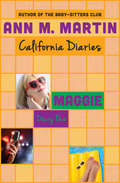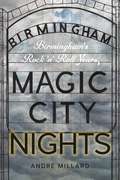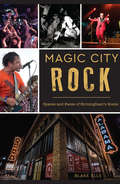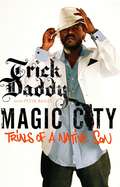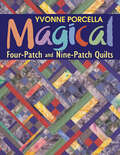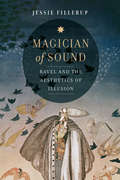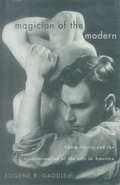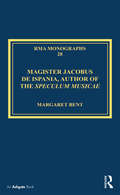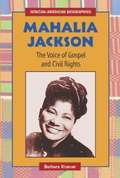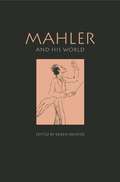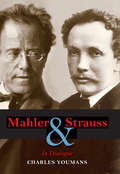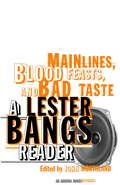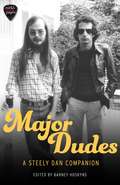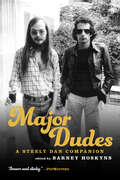- Table View
- List View
Maggie: Dawn, Sunny, Maggie, Amalia, And Ducky (California Diaries #3)
by Ann M. MartinMaggie makes everything she does look easy--but there's a high price to pay for perfectionMaggie Blume does everything right. She gets straight A's, is a talented pianist, and was just named the youngest poetry editor of the school's literary magazine, Inner Vistas. She makes the life of a successful thirteen-year-old look easy.For Maggie's father, nothing but perfect will do. Not only is he obsessed with his job as a studio executive, he expects Maggie to have a detailed plan for her life, which unfortunately leaves no room for her true passion: music.Once Maggie's friends learn of her talent, they help her land a spot as the lead singer for Vanish, the band managed by her friend Amalia. Maggie could never share this news with her dad, so when she has to choose between going to his movie opening and the battle of the bands, she takes a huge risk to make sure she's able to do it all--perfectly.This ebook features an illustrated personal history of Ann M. Martin, including rare images from the author's collection.
Magic Circles: The Beatles in Dream and History
by Devin McKinneyNo one expressed the heart and soul of the Sixties as powerfully as the Beatles did through the words, images, and rhythms of their music. In Magic Circles Devin McKinney uncovers the secret history of a generation and a pivotal moment in twentieth-century culture. He reveals how the Beatles enacted the dream life of their time and shows how they embodied a kaleidoscope of desire and anguish for all who listened--hippies or reactionaries, teenage fans or harried parents, Bob Dylan or Charles Manson. The reader who dares to re-enter the vortex that was the Sixties will appreciate, perhaps for the first time, much of what lay beneath the social trauma of the day. <P><P>Delving into concerts and interviews, films and music, outtakes and bootlegs, Devin McKinney brings to bear the insights of history, aesthetics, sociology, psychology, and mythology to account for the depth and resonance of the Beatles' impact. His book is also a uniquely multifaceted appreciation of the group's artistic achievement, exploring their music as both timeless expression and visceral response to their historical moment. Starting in the cellars of Liverpool and Hamburg, and continuing through the triumph of Beatlemania, the groundbreaking studio albums, and the last brutal, sorrowful thrust of the White Album, Magic Circles captures both the dream and the reality of four extraordinary musicians and their substance as artists. At once an entrancing narrative and an analytical montage, the book follows the drama, comedy, mystery, irony, and curious off-ramps of investigation and inquiry that contributed to one of the most amazing odysseys in pop culture.
Magic City Nights: Birmingham’s Rock ’n’ Roll Years
by Andre MillardThis exploration of rock ’n’ roll music and culture in Birmingham, Alabama, is based on the oral histories of musicians, their fans and professionals in the popular music industry. Collected over a twenty-year period, their stories describe the coming of rock ’n’ roll in the 1950s, the rise of the garage bands in the 1960s, of southern rock in the 1970s, and of alternative music in the 1980s and 1990s. Told in the words of the musicians themselves, Magic City Nights provides an insider’s view of the dramatic changes in the business and status of popular music from the era of the vacuum tube to twenty-first-century digital technology. These collective memories offer a unique perspective on the impact of a subversive and racially integrated music culture in one of the most conservative and racially divided cities in the country.
Magic City Rock: Spaces and Faces of Birmingham’s Scene
by Blake EllsBirmingham's rock music scene has thrived on camaraderie and collaboration for decades. With no competitiveness, it has maintained a punk rock ethos while also appealing to a mainstream audience, thanks to DIY clubs and alternative radio support. Once one of the country's most successful AAA radio stations, 107.7 The X and the A&R power of station head Scott Register provided the early radio success that helped break Train, Matchbox Twenty and John Mayer. The same scene produced Jim Bob & the Leisure Suits, the Primitons, the Sugar La Las and Verbena. From local legends like Hotel and Telluride to national sensation St. Paul and the Broken Bones, writer Blake Ells tells the story of the Magic City's indelible stamp on the history of modern rock.
Magic City: Trials of a Native Son
by Peter Bailey Trick Daddy"A thug is someone who stands on his own. He lives by the decisions he makes and accepts the consequences. A thug is comfortable in his own skin. I wear mine like a glove." Trick Daddy was born a thug--just a stone's throw from downtown Miami, yet a world away from its dazzling beauty and sparkling wealth. Where grinding poverty, deadly crime, and devastating racial tension taught kids to live by the 'hood rules. Remarkably, Trick came from nothing and made it big just when his chances had run out. Magic City is the extraordinary tale of a boy whose father was a pimp, who learned to hustle to survive, and whose only role model was his brother, the drug dealer he watched plying his trade on the block. It's the untold truth behind the cult movie Scarface, of the drug money that transformed the city into a shining mecca for the rich and famous while turf wars between smalltime pushers claimed countless lives. It's also the incredible story of how that potent mixture of extremes--the electric pulse and glittering abundance of South Beach and the crime, corruption, and despair in its shadows--gave rise to the most dominant sound in hip-hop today. Magic City is an ode to Miami, a riveting tale of a paradise lost and a native son determined to infuse it with new life.
Magical Four-Patch and Nine-Patch
by Yvonne PorcellaNoted fiber artist Yvonne Porcella turns her talents to the most basic quilt block patterns, Four-Patches and Nine-Patches, and she will turn your world upside down! Join her on the journey to creating your own innovative quilts. 10 incredible quilting projects. Quilts are constructed using simple strip piecing and foundation piecing. Yvonne's "e;Magical Numbering System"e; makes choosing fabrics practically painless. Suggestions for personalizing your work to make it yours alone.
Magician of Sound: Ravel and the Aesthetics of Illusion (California Studies in 20th-Century Music #29)
by Jessie FillerupFrench composer Maurice Ravel was described by critics as a magician, conjurer, and illusionist. Scholars have been aware of this historical curiosity, but none so far have explained why Ravel attracted such critiques or what they might tell us about how to interpret his music. Magician of Sound examines Ravel's music through the lens of illusory experience, considering how timbre, orchestral effects, figure/ground relationships, and impressions of motion and stasis might be experienced as if they were conjuring tricks. Applying concepts from music theory, psychology, philosophy, and the history of magic, Jessie Fillerup develops an approach to musical illusion that newly illuminates Ravel's fascination with machines and creates compelling links between his music and other forms of aesthetic illusion, from painting and poetry to fiction and phantasmagoria. Fillerup analyzes scenes of enchantment and illusory effects in Ravel's most popular works, including Boléro, La Valse, Daphnis et Chloé, and Rapsodie espagnole, relating his methods and musical effects to the practice of theatrical conjurers. Drawing on a rich well of primary sources, Magician of Sound provides a new interdisciplinary framework for interpreting this enigmatic composer, linking magic and music.
Magician of the Modern: Chick Austin and the Transformation of the Arts in America
by Eugene R. GaddisThe story of Chick Austin is the story, in Virgil Thomson's words, of "a whole cultural movement in one man." Becoming director of Hartford's Wadsworth Atheneum at the age of twenty-six, Austin immediately set about to introduce modern art to America and to transform this conservative insurance capital into a cultural mecca that would become the talk of the art world during the yeasty years between the two world wars.The first in the United States to mount a major Picasso retrospective, Austin was soon acquiring works by Dalí, Mondrian, Miró, Balthus, Max Ernst, and Alexander Calder. In the museum's new theater (which he designed), he staged the premiere of the revolutionary Gertrude Stein and Virgil Thomson opera Four Saints in Three Acts (with an all-black cast). At Lincoln Kirstein's instigation, he brought Balanchine to America. And he embraced all the new art forms, making film, photography, architecture, and contemporary music part of the life of his museum. For his own family he built a Palladian villa (now a recently restored national historic landmark), filling it with the baroque and the Bauhaus and inviting all the locals in to see how it felt to be modern.Austin's instinct for quality proved infallible. Whether acquiring a matchless Caravaggio or a startling Dalí, he balanced the old masters with the modern. Mounting provocative shows that linked the past to the present, he created dramatic installations--and he threw himself into everything, hanging fabrics, creating backdrops, stitching up costumes. He loved to teach, to paint, to act, to give lavish costume balls, and to dazzle audiences of all ages with his performances as a magician, the Great Osram.Brilliant at using his magician's sleight of hand, he could manipulate his conservative trustees to get what he wanted--but only up to a point. One more purchase of an incomprehensible abstract canvas, one outrageous party too many, one more shocking theatrical role, eventually led to a crisis. Never one to be idle for long, Austin left Hartford and took on a new challenge--to make an artistic triumph of the pink-and-white palace in Sarasota, Florida, known as the John and Mable Ringling Museum of Art, which housed the circus king's moldering but magnificent collection.Here is the colorful life of Chick Austin, and as we relish his audacious career--the risks he took, the successes he enjoyed along with the inevitable setbacks--we understand what a far-reaching influence he had on the way Americans look at and think about art. Not only a brilliant portrait of an extraordinary man, this wonderfully American story gives us a fascinating behind-the-scenes glimpse into the art world as it was then--and in many ways still is today.From the Hardcover edition.
Magister Jacobus de Ispania, Author of the Speculum musicae (Royal Musical Association Monographs)
by Margaret BentThe Speculum musicae of the early fourteenth century, with nearly half a million words, is by a long way the largest medieval treatise on music, and probably the most learned. Only the final two books are about music as commonly understood: the other five invite further work by students of scholastic philosophy, theology and mathematics. For nearly a century, its author has been known as Jacques de Liège or Jacobus Leodiensis. ’Jacobus’ is certain, fixed by an acrostic declared within the text; Liège is hypothetical, based on evidence shown here to be less than secure. The one complete manuscript, Paris BnF lat. 7207, thought by its editor to be Florentine, can now be shown on the basis of its miniatures by Cristoforo Cortese to be from the Veneto, datable c. 1434-40. New documentary evidence in an Italian inventory, also from the Veneto, describes a lost copy of the treatise dating from before 1419, older than the surviving manuscript, and identifies its author as ’Magister Jacobus de Ispania’. If this had been known eighty years ago, the Liège hypothesis would never have taken root. It invites a new look at the geography and influences that played into this central document of medieval music theory. The two new attributes of ’Magister’ and ’de Ispania’ (i.e. a foreigner) prompted an extensive search in published indexes for possible identities. Surprisingly few candidates of this name emerged, and only one in the right date range. It is here suggested that the author of the Speculum is either someone who left no paper trail or James of Spain, a nephew of Eleanor of Castile, wife of King Edward I, whose career is documented mostly in England. He was an illegitimate son of Eleanor’s older half-brother, the Infante Enrique of Castile. Documentary evidence shows that he was a wealthy and well-travelled royal prince who was also an Oxford magister. The book traces his career and the likelihood of his authorship of the Speculum musicae.
Magnifico!: The A to Z of Queen
by Mark Blake&“An engaging mix of humor and detailed critical analysis…great fun.&” —Mojo From the award-winning author of Bring It On Home: Peter Grant, Led Zeppelin, and Beyond and Comfortably Numb: The Inside Story of Pink Floyd comes this deeply researched alphabetical biography of Queen and each of its dynamic members.Addressing the phenomenal success of the movie Bohemian Rhapsody, acclaimed music journalist Mark Blake builds on the legend of Queen and their enduring audience appeal. Providing a fresh, unparalleled take on Queen&’s music, story, and legacy, Blake&’s complete portrait covers not only the major hits and bestselling albums, but also the inside stories behind the music. Via a series of essays, interviews, and biographies, the author shares a wealth of lesser-known details—gained from over thirty years of original material—and explores what the songs of Queen say about their creators. &“You want it all? There&’s not much missing here.&” —Classic Rock
Mahalia Jackson: The Voice of Gospel and Civil Rights
by Barbara KramerBiography of African-American singer Mahalia Jackson.
Mahler and His World (The Bard Music Festival #49)
by Karen PainterFrom the composer's lifetime to the present day, Gustav Mahler's music has provoked extreme responses from the public and from experts. Poised between the Romantic tradition he radically renewed and the austere modernism whose exponents he inspired, Mahler was a consummate public persona and yet an impassioned artist who withdrew to his lakeside hut where he composed his vast symphonies and intimate song cycles. His advocates have produced countless studies of the composer's life and work. But they have focused on analysis internal to the compositions, along with their programmatic contexts. In this volume, musicologists and historians turn outward to examine the broader political, social, and literary changes reflected in Mahler's music. Peter Franklin takes up questions of gender, Talia Pecker Berio examines the composer's Jewish identity, and Thomas Peattie, Charles S. Maier, and Karen Painter consider, respectively, contemporary theories of memory, the theatricality of Mahler's art and fin-de-siècle politics, and the impinging confrontation with mass society. The private world of Gustav Mahler, in his songs and late works, is explored by leading Austrian musicologist Peter Revers and a German counterpart, Camilla Bork, and by the American Mahler expert Stephen Hefling. Mahler's symphonies challenged Europeans and Americans to experience music in new ways. Before his decision to move to the United States, the composer knew of the enthusiastic response from America's urban musical audiences. Mahler and His World reproduces reviews of these early performances for the first time, edited by Zoë Lang. The Mahler controversy that polarized Austrians and Germans also unfolds through a series of documents heretofore unavailable in English, edited by Painter and Bettina Varwig, and the terms of the debate are examined by Leon Botstein in the context of the late-twentieth-century Mahler revival.
Mahler and Strauss: In Dialogue
by Charles YoumansA rare case among history's great music contemporaries, Gustav Mahler (1860-1911) and Richard Strauss (1864-1949) enjoyed a close friendship until Mahler's death in 1911. Unlike similar musical pairs (Bach and Handel, Haydn and Mozart, Schoenberg and Stravinsky), these two composers may have disagreed on the matters of musical taste and social comportment, but deeply respected one another's artistic talents, freely exchanging advice from the earliest days of professional apprenticeship through the security and aggravations of artistic fame. Using a wealth of documentary material, this book reconstructs the 24-year relationship between Mahler and Strauss through collage--"a meaning that arises from fragments," to borrow Adorno's characterization of Mahler's Sixth Symphony. Fourteen different topics, all of central importance to the life and work of the two composers, provide distinct vantage points from which to view both the professional and personal relationships. Some address musical concerns: Wagnerism, program music, intertextuality, and the craft of conducting. Others treat the connection of music to related disciplines (philosophy, literature), or to matters relevant to artists in general (autobiography, irony). And the most intimate dimensions of life--childhood, marriage, personal character--are the most extensively and colorfully documented, offering an abundance of comparative material. This integrated look at Mahler and Strauss discloses provocative revelations about the two greatest western composers at the turn of the 20th century.
Mahler in Context (Composers in Context)
by Charles YoumansMahler in Context explores the institutions, artists, thinkers, cultural movements, socio-political conditions, and personal relationships that shaped Mahler's creative output. Focusing on the contexts surrounding the artist, the collection provides a sense of the complex crosscurrents against which Mahler was reacting as conductor, composer, and human being. Topics explored include his youth and training, performing career, creative activity, spiritual and philosophical influences, and his reception after his death. Together, this collection of specially commissioned essays offers a wide-ranging investigation of the ecology surrounding Mahler as a composer and a fuller appreciation of the topics that occupied his mind as he conceived his works. Readers will benefit from engagement with lesser known dimensions of Mahler's life. Through this broader contextual approach, this book will serve as a valuable and unique resource for students, scholars, and a general readership.
Mahler's Symphonic World: Music for the Age of Uncertainty
by Karol BergerA new analysis of Mahler’s symphonies, placing each within the context of his musical way of being in and experiencing the world. Between 1888 and 1909 Gustav Mahler completed nine symphonies and the orchestral song cycle Das Lied von der Erde; his tenth symphony was left incomplete at his death in 1911. Mahler’s Symphonic World provocatively suggests that over his lifetime, the composer pursued a single vision and a single, ideal symphony that strived to capture his personal outlook on human existence. Writing at the turn of the twentieth century, when all trust in firm philosophical and spiritual foundations had evaporated, Mahler’s music reflected a deep preoccupation with human suffering and transience and a search for sources of possible consolation. In Karol Berger’s reading, each of the symphonies follows a similar trajectory, with an opening quest leading to the final unveiling of a transcendent, consolatory vision. By juxtaposing single movements—the opening Allegros, the middle movements, the Finales—across different works, Berger traces recurring plotlines and imagery and discloses the works’ multiple interrelationships as well as their cohesiveness around a central idea. Ultimately, Mahler’s Symphonic World locates Mahler’s music within the matrix of intellectual currents that defined his epoch and offers a revelatory picture of his musical way of being in the world.
Mahler: A Musical Physiognomy
by Theodor W. AdornoTheodor W. Adorno goes beyond conventional thematic analysis to gain a more complete understanding of Mahler's music through his character, his social and philosophical background, and his moment in musical history. Adorno examines the composer's works as a continuous and unified development that began with his childhood response to the marches and folk tunes of his native Bohemia. Since its appearance in 1960 in German, Mahler has established itself as a classic of musical interpretation. Now available in English, the work is presented here in a translation that captures the stylistic brilliance of the original. Theodor W. Adorno (1903-69), one of the foremost members of the Frankfurt school of critical theory, studied with Alban Berg in Vienna during the late twenties, and was later the director of the Institute of Social Research at the University of Frankfurt from 1956 until his death. His works include Aesthectic Theory, Introduction to the Sociology of Music, The Jargon of Authenticity, Prism, and Philosophy of Modern Music.
Main Lines, Blood Feasts, and Bad Taste
by John Morthland Lester BangsBefore his untimely death in 1982, Lester Bangs was inarguably the most influential critic of rock and roll. Writing in hyper-intelligent Benzedrine prose that calls to mind Jack Kerouac and Hunter S. Thompson, he eschewed all conventional thinking as he discussed everything from Black Sabbath being the first truly Catholic band to Anne Murray's smoldering sexuality. In Mainlines, Blood Feasts, Bad Taste fellow rock critic John Morthland has compiled a companion volume to Psychotic Reactions and Carburetor Dung, the first, now classic collection of Bangs's work. Here are excerpts from an autobiographical piece Bangs wrote as a teenager, travel essays, and, of course, the music pieces, essays, and criticism covering everything from titans like Miles Davis, Lou Reed, and the Rolling Stones to esoteric musicians like Brian Eno and Captain Beefheart. Singularly entertaining, this book is an absolute must for anyone interested in the history of rock.From the Trade Paperback edition.
Main Lines, Blood Feasts, and Bad Taste: A Lester Bangs Reader
by John MorthlandBefore his untimely death in 1982, Lester Bangs was arguably the most influential critic of rock and roll. Writing in hyper-intelligent Benzedrine prose that calls to mind Jack Kerouac and Hunter S. Thompson, he eschewed all conventional thinking as he discussed everything from Black Sabbath being the first truly Catholic band to Anne Murray's smoldering sexuality. In Mainlines, Blood Feasts, Bad Taste fellow rock critic John Morthland has compiled a companion volume to Psychotic Reactions and Carburetor Dung, the first, now classic collection of Bangs's work. Here are excerpts from an autobiographical piece Bangs wrote as a teenager, travel essays, and, of course, the music pieces, essays, and criticism covering everything from titans like Miles Davis, Lou Reed, and the Rolling Stones to esoteric musicians like Brian Eno and Captain Beefheart. Singularly entertaining, this book is an absolute must for anyone interested in the history of rock.
Mainframe Experimentalism: Early Computing and the Foundations of the Digital Arts
by Douglas Kahn Hannah B. HigginsMainframe Experimentalism challenges the conventional wisdom that the digital arts arose out of Silicon Valley’s technological revolutions in the 1970s. In fact, in the 1960s, a diverse array of artists, musicians, poets, writers, and filmmakers around the world were engaging with mainframe and mini-computers to create innovative new artworks that contradict the stereotypes of "computer art." Juxtaposing the original works alongside scholarly contributions by well-established and emerging scholars from several disciplines, Mainframe Experimentalism demonstrates that the radical and experimental aesthetics and political and cultural engagements of early digital art stand as precursors for the mobility among technological platforms, artistic forms, and social sites that has become commonplace today.
Major Dudes: A Steely Dan Companion
by Barney Hoskyns'An indispensable compendium for Steely Dan fans' The WireAt its core a creative marriage between Donald Fagen and Walter Becker, Steely Dan are one of the defining and bestselling American rock acts of the last half-century, recording several of the cleverest and best-produced albums of the '70s - from the breathlessly catchy Can't Buy a Thrill to the sleekly sinister Gaucho.In the '90s they returned to remind us of how sorely we had missed their elegance and erudition, subsequently recording Two Against Nature and Everything Must Go during the following decade. They have sold close to forty-five million albums.'A lot of people think of them as the epitome of boring '70s stuff,' novelist William Gibson said in 1993, when Becker and Fagen toured for the first time in nineteen years. 'They don't realize this is probably the most subversive material pop has ever thrown up.'Now fully embraced by the 'Yacht Rock' generation - semi-ironic devotees of '70s Southern-California slickness - Steely Dan no longer polarize lo-fi punks and studio geeks in the way they used to. In 2001 they were inducted into the Rock and Roll Hall of Fame.Major Dudes collects some of the smartest and wittiest interviews Becker and Fagen have ever given, along with insightful reviews of - and commentary on - their extraordinary songs. Compiled by Rock's Backpages editor Barney Hoskyns, the book's contributors include Charles Shaar Murray, Robert Palmer, Ian MacDonald, Bud Scoppa, Penny Valentine, Fred Schruers, Sylvie Simmons and Michael Watts.
Major Dudes: A Steely Dan Companion
by Barney Hoskyns'An indispensable compendium for Steely Dan fans' The WireAt its core a creative marriage between Donald Fagen and Walter Becker, Steely Dan are one of the defining and bestselling American rock acts of the last half-century, recording several of the cleverest and best-produced albums of the '70s - from the breathlessly catchy Can't Buy a Thrill to the sleekly sinister Gaucho.In the '90s they returned to remind us of how sorely we had missed their elegance and erudition, subsequently recording Two Against Nature and Everything Must Go during the following decade. They have sold close to forty-five million albums.'A lot of people think of them as the epitome of boring '70s stuff,' novelist William Gibson said in 1993, when Becker and Fagen toured for the first time in nineteen years. 'They don't realize this is probably the most subversive material pop has ever thrown up.'Now fully embraced by the 'Yacht Rock' generation - semi-ironic devotees of '70s Southern-California slickness - Steely Dan no longer polarize lo-fi punks and studio geeks in the way they used to. In 2001 they were inducted into the Rock and Roll Hall of Fame.Major Dudes collects some of the smartest and wittiest interviews Becker and Fagen have ever given, along with insightful reviews of - and commentary on - their extraordinary songs. Compiled by Rock's Backpages editor Barney Hoskyns, the book's contributors include Charles Shaar Murray, Robert Palmer, Ian MacDonald, Bud Scoppa, Penny Valentine, Fred Schruers, Sylvie Simmons and Michael Watts.
Major Dudes: A Steely Dan Companion
by Barney HoskynsThe ultimate anthology of Steely Dan, one of the defining and bestselling rock acts of the last half-century At its core a creative marriage between Donald Fagen and Walter Becker, Steely Dan has sold over 45 million albums and recorded several of the cleverest and best-produced albums of the 1970s—from the breathlessly catchy Can’t Buy a Thrill to the sleekly sinister Gaucho—making them one of the most successful rock acts of the past fifty years. More than ten years after their break-up in 1981, they returned to remind fans of how sorely they had missed their elegance and erudition, subsequently recording Two Against Nature and Everything Must Go during the following decade, touring continuously, and being inducted into the Rock and Roll Hall of Fame in 2001. Major Dudes collects some of the smartest and wittiest interviews Becker and Fagen have ever given, along with insightful reviews of—and commentary on—their extraordinary songs. Compiled by leading music critic and writer Barney Hoskyns, Major Dudes features contributions from Chris Van Ness, Steven Rosen, and the late Robert Palmer, and pieces including rare interviews and reviews of Steely Dan’s early albums from Disc, Melody Maker, and Rolling Stone. With an afterword examining the musical legacy of and memorializing the late Walter Becker, who since his passing Rolling Stone has heralded as the “brilliant perfectionist behind one of rock’s most eccentric bands,” Major Dudes is the most comprehensive anthology of Steely Dan ever compiled and will be the centerpiece on every fan’s shelf.
Major Labels: A History of Popular Music in Seven Genres
by Kelefa SannehAn epic achievement and a huge delight, the entire history of popular music over the past fifty years refracted through the big genres that have defined and dominated it: rock, R&B, country, punk, hip-hop, dance music, and pop. <p><p> Kelefa Sanneh, one of the essential voices of our time on music and culture, has made a deep study of how popular music unites and divides us, charting the way genres become communities, shape-shifting across the years, giving us a way to track larger forces and controversies. In Major Labels, Sanneh distills a career’s worth of knowledge about music and musicians into a brilliant and omnivorous reckoning with popular music—as an art form (actually, a bunch of art forms), as a cultural and economic force, and as a tool that we use to build our identities. <p><p> As Sanneh unspools the stories of the genres that have defined popular music, the connections build, and big themes accrue momentum: the tension between mainstream and outsider, between authenticity and phoniness, between good and bad, right and wrong. Throughout, race is a powerful touchstone: just as there have always been Black audiences and white audiences, with more or less overlap depending on the moment, there has been Black music and white music, constantly mixing and separating. Sanneh debunks cherished myths, reappraises beloved heroes, and upends familiar ideas of musical greatness, arguing that sometimes, the best popular music isn’t transcendent. It expresses our grudges as well as our hopes, and it is motivated by greed as well as inspiration; music is a powerful tool for human connection, but also for human antagonism. <p><p> The book will intoxicate music nerds, even as it serves as a heady gateway drug for occasional listeners, or even non-listeners. The opposite of a modest proposal, Major Labels takes on the whole extraordinary range of popular music over the past half century, and it pays in full.
Major Scale Guitar Licks: 10 Original Soft Rock Licks with Audio & Video (Modal Guitar Licks #1)
by Gareth Evans10 original soft rock guitar licks from the major scale in tablature and notation for the progressing guitarist at intermediate level and above. >> 53 bars of music over 10 licks (average lick length 5.3 bars) >> Video at full speed & Audio at full & half speed (Downloadable) >> Backing tracks at full and slower practise speeds (Downloadable) >> Scale diagrams with theory and technique tips for each lick >> Guitar tablature has picking directions & fretting finger guide numbers Please Note: This eBook has written music and is not suitable for smaller screens.
Make It New: Reshaping Jazz in the 21st Century
by Bill BeuttlerAs jazz enters its second century it is reasserting itself as dynamic and relevant. Boston Globe jazz writer and Emerson College professor Bill Beuttler reveals new ways in which jazz is engaging with society through the vivid biographies and music of Jason Moran, Vijay Iyer, Rudresh Mahanthappa, The Bad Plus, Miguel Zenón, Anat Cohen, Robert Glasper, and Esperanza Spalding. These musicians are freely incorporating other genres of music into jazz—from classical (both western and Indian) to popular (hip-hop, R&B, rock, bluegrass, klezmer, Brazilian choro)—and other art forms as well (literature, film, photography, and other visual arts). This new generation of jazz is increasingly more international and is becoming more open to women as instrumentalists and bandleaders. Contemporary jazz is reasserting itself as a force for social change, prompted by developments such as the Black Lives Matter, #MeToo movements, and the election of Donald Trump.
